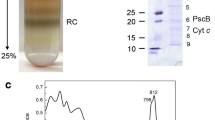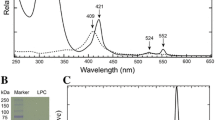Abstract
The cytochromes of photosynthetically grown Rhodopseudomonas blastica have been thermodynamically characterized using the technique of redox titrations. Six cytochromes were present; two cytochromes c, E m7= +295mV, E m7=+345mV; and four cytochromes b, E m7=+290mV, E m7=+130mV, E m7=+60mV, E m7=-4mV. These cytochromes were tightly bound except for cytochrome c with E m7 of+345mV which was mostly present in the soluble cell extracts.
The effects of cyanide on both the cytochrome c oxidase activity and the NADH-dependent respiration, revealed the presence of a branched respiratory chain, one branch leading to a cyanide-resistant oxidase containing pathway and the other including the cyanide-sensitive cytochrome c-oxidase.
The effects of antimycin A, myxothiazol and 5-undecyl-6-hydroxy-4,7-dioxobenzothiazole (UHDBT) on the steadystate NADH-dependent respiration were also studied. Antimycin A and myxothiazol appeared to act at the level of the ubiquinol-cytochrome c oxidoreductase while UHDBT drastically affected both respiratory branches.
Absorption spectra of chromatophore photopigments resulted to be similar to those reported in many species of facultative photosynthetic bacteria although carotenoid absorption maxima were blue-shifted by 5 nm.
The light-induced oxygen reduction performed by chromatophores from R. blastica suggested a strict interaction between photosynthetic and respiratory apparatuses.
Similar content being viewed by others
References
Baccarini-Melandri A, Zannoni D, Melandri BA (1973) Energy transduction in photosynthetic bacteria. VI. Respiratory sites of energy conservation in membranes from dark-grown cells of Rhodopseudomonas capsulata. Biochim Biophys Acta 314:298–311
Bevington PR (1969) Data reduction and error analysis for the physical sciences. Mc Graw Hill, New York
Bowyer JR (1979) Light driven electron transfer reactions in photosynthetic bacteria. Thesis, University of Bristol
Casadio R, Baccarini-Melandri A, Melandri BA (1978) Limited cooperativity in the coupling between electron flow and photosynthetic ATP-synthesis. FEBS Lett 87:323–328
Chance B (1957) Techniques for the assay of respiratory enzymes. In: Colowick SP, Kaplan NO (eds) Methods in enzymology, vol 4. Academic Press, New York, pp 273–342
Clayton RK (1966) Spectroscopic analysis of bacteriochlorophylls in vitro and in vivo. Photochem Photobiol 5:669–677
Cogdell RJ, Thornber JP (1980) Light harvesting pigment-protein complexes of purple photosynthetic bacteria. FEBS Lett 122:1–8
Cramer WA, Crofts AR (1982) Electron and proton transport, In: Govindjee (eds) Photosynthesis. Energy conversion by plants and bacteria, vol I. Academic Press, New York, pp 387–467
Crofts AR (1984) The mechanism of the ubiquinol: cytochrome c oxidoreductases of mitochondria and of Rhodopseudomonas sphaeroides. In: Martonosi AN (ed) The enzymes of biological membranes, 2nd ed. Plenum Publ Comp, New York (in press)
Drews G, Oelze J (1981) Organization and differentiation of membranes of photosynthetic bacteria. In: Rose AH, Morris JG (eds) Advances in microbial physiology, vol 22. Academic Press, London, pp 1–92
Dutton PL, Wilson DF, Lee CP (1970) Oxidation-reduction potentials of cytochromes in mitochondria. Biochemistry 9:5077–5082
Eckersley K, Dow CS (1980) Rhodopseudomonas blastica sp. nov.: A member of the Rhodospirillaceae. J Gen Microbiol 119: 465–473
Feldman N, Gromet-Elhanan Z (1972) Non-cyclic electron transport and photophosphorylation in Rhodospirillum rubrum chromatophores. In: Forti G, Avron M, Melandri BA (eds) Proceedings on the II nd Intern. Cong. on Photosynthesis Research, vol 2. W. Junk, The Hague, pp 1211–1220
Gorlenko VM, Keppen OI, Puchkov AN (1976) Morphological differentiation in nonsulphur purple bacteria. Microbiology (English translation of Mikrobiologiya) 45:705–710
Gromet-Elhanan Z (1970) Differences in sensitivity to valinomycin and nonactin of various photophosphorylating and photoreducing systems of Rhodospirillum rubrum chromatophores. Biochim Biophys Acta 223:174–182
Jagow G von, Engel WD (1981) Complete inhibition of electron transfer from ubiquinol to cytochrome b by the combined action of antimycin and myxothiazol. FEBS Lett 136:19–24
Keister DL (1978) Respiration vs. Photosynthesis. In: Clayton RK, Sistrom WR (eds) The photosynthetic bacteria. Plenum Press, New York London, pp 849–856
Lommen MAJ, Takemoto J (1978) Ultrastructure of carotenoid mutant strain R-26 of Rhodopseudomonas sphaeroides. Arch Microbiol 118:305–308
Lowry OH, Rosebrough NJ, Farr AL, Randall RJ (1951) Protein measurement with Folin phenol reagent. J Biol Chem 193:265–275
Pfennig N (1977) Phototrophic green and purple bacteria: a comparative, systematic survey. Ann Rev Microbiol 31:275–290
Saunders V, Jones OTG (1974) Oxidative phosphorylations and effects of aerobic conditions in Rhodopseudomonas viridis. Biochim Biophys Acta 305:581–589
Schmidt K (1978) Biosynthesis of carotenoids. In: Clayton RK, Sistrom WR (eds) The photosynthetic bacteria. Plenum Press, New York, pp 729–750
Schmidt K, Bowien B (1983) Notes on the description of Rhodopseudomonas blastica. Arch Microbiol 136:242
Scolnik PA, Zannoni D, Marrs BL (1980) Spectral and functional comparison between the carotenoids of the two antenna complexes of Rhodopseudomonas capsulata. Biochim Biophys Acta 593:230–240
Trumpower BL (1981) Function of the iron-sulphur protein in the cytochrome b-c1 segment in the electron transfer and energy conserving reactions of the mitochondrial respiratory chain. Biochim Biophys Acta 639:129–155
Wood PM (1983) Why do c-type cytochromes exists? FEBS Lett 164:223–226
Zannoni D, Baccarini-Melandri A (1980) Respiratory electron flow in facultative photosynthetic bacteria. In: Knowles CJ (ed) Diversity of bacterial respiratory systems, vol II. CRC Press, Boca Raton, pp 183–202
Zannoni D, Marrs BL (1978) Tentative proposal of two carotenoid pools associated with the photosynthetic apparatus of Rhodopseudomonas capsulata. In: Sojka G, Gest H (eds) Abstract 5 th Ann. Conf. Molecular Biol. Photosynt. Prokaryotes., University of Indiana, pp 66
Zannoni D, Jasper P, Marrs BL (1978) Light induced oxygen reduction as a probe of electron transport between respiratory and photosynthetic components in membranes of Rhodopseudomonas capsulata. Arch Biochem Biophys 191:625–631
Author information
Authors and Affiliations
Rights and permissions
About this article
Cite this article
Zannoni, D. Spectral and functional characterization of membrane fragments from the facultative photosynthetic bacterium Rhodopseudomonas blastica . Arch. Microbiol. 140, 15–20 (1984). https://doi.org/10.1007/BF00409765
Received:
Accepted:
Issue Date:
DOI: https://doi.org/10.1007/BF00409765




